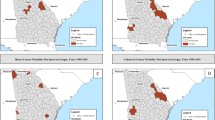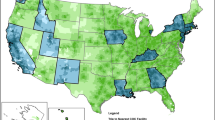Abstract
Purpose
To address locally relevant cancer-related health issues, health departments frequently need data beyond that contained in standard census area-based statistics. We describe a geographic information system-based method for calculating age-standardized cancer incidence rates in non-census defined geographical areas using publically available data.
Methods
Aggregated records of cancer cases diagnosed from 2009 through 2013 in each of Chicago’s 77 census-defined community areas were obtained from the Illinois State Cancer Registry. Areal interpolation through dasymetric mapping of census blocks was used to redistribute populations and case counts from community areas to Chicago’s 50 politically defined aldermanic wards, and ward-level age-standardized 5-year cumulative incidence rates were calculated.
Results
Potential errors in redistributing populations between geographies were limited to <1.5% of the total population, and agreement between our ward population estimates and those from a frequently cited reference set of estimates was high (Pearson correlation r = 0.99, mean difference = −4 persons). A map overlay of safety-net primary care clinic locations and ward-level incidence rates for advanced-staged cancers revealed potential pathways for prevention.
Conclusions
Areal interpolation through dasymetric mapping can estimate cancer rates in non-census defined geographies. This can address gaps in local cancer-related health data, inform health resource advocacy, and guide community-centered cancer prevention and control.



Similar content being viewed by others
References
Desmond-Hellman S, Sawyers CL (2011) Committee on a framework for development a new taxonomy of disease; National Research Council. Why now? In: National Research Council (ed) Toward precision medicine: building a knowledge network for biomedical research and a new taxonomy of disease. National Academies Press, Washington, DC, pp 21–39
Collins FS, Varmus H (2015) A new initiative on precision medicine. N Engl J Med 372:793–795
https://www.whitehouse.gov/the-press-office/2015/01/30/remarks-president-precision-medicine. Accessed 14 Jan 2017
Khoury MJ, Iademarco MF, Riley WT (2016) Precision public health for the era of precision medicine. Am J Prev Med 50:398–401
Naishadham D, Lansdorp-Vogelaar I, Siegel R, Cokkinides V, Jemal A (2011) State disparities in colorectal cancer mortality patterns in the United States. Cancer Epidemiol Biomark Prev 20:1296–1302
U.S. Cancer Statistics Working Group (2016) United States cancer statistics: 1999–2013 incidence and mortality web-based report. U.S. Department of Health and Human Services, Centers for Disease Control and Prevention and National Cancer Institute, Atlanta. www.cdc.gov/uscs
Himmelstein DU, Woolhandler S (2016) Public health’s falling share of US health spending. Am J Public Health 106:56–57
Simon PA, Wold CM, Cousineau MR, Fielding JE (2001) Meeting the data needs of a local health department: the Los Angeles County Health Survey. Am J Public Health 91:1950–1952
Fisher PF, Langford M (1996) Modeling sensitivity to accuracy in classified imagery: a study of areal interpolation by dasymetric mapping. Prof Geogr 48:299–309
City of Chicago City Council (2016) Description of City of Chicago aldermanic roles. http://www.cityofchicago.org/city/en/about/council.html. Accessed 29 Sept 2016
Chicago Fact Book Consortium (1995) Local community fact book: Chicago metropolitan area, 1990. Academy Chicago Publishers, Chicago
Shah AM, Whitman S, Silva A (2006) Variations in the health conditions of 6 Chicago community areas: a case for local-level data. Am J Public Health 96:1485–1491
Illinois Department of Public Health, Illinois State Cancer Registry, public data set v23, 1986–2013, data as of November 2015: http://www.idph.state.il.us/cancer/16/READMEv23ChicagoCA.pdf. Accessed 23 Jan 2017
U.S. Decennial Census Summary File 1, Table P12, Total Population Sex by Age. http://factfinder.census.gov/faces/tableservices/jsf/pages/productview.xhtml?pid=DEC_00_SF1_P012&prodType=table. Accessed 23 Jan 2017
TIGER/Line tracts and blocks: https://www.census.gov/geo/maps-data/data/tiger-line.html. Accessed 23 Jan 2017
Chicago Ward Boundaries (2016) https://data.cityofchicago.org/Facilities-Geographic-Boundaries/Boundaries-Wards-2015-/sp34-6z76. Accessed 29 Sept 2016
Chicago Community Area Boundaries (2017) https://data.cityofchicago.org/Facilities-Geographic-Boundaries/Boundaries-Community-Areas-current-/cauq-8yn6. Accessed 23 Jan 2017
United States Census Bureau, American Community Survey, Data Suppression Practices, September 27, 2016. http://www2.census.gov/programs-surveys/acs/tech_docs/data_suppression/ACSO_Data_Suppression.pdf. Accessed 3 Feb 2017
Ramos E (2017) Interactive: City Council-approved Chicago Ward Map [Internet]. WBEZ Chicago. https://www.wbez.org/shows/wbez-news/interactive-city-councilapproved-chicago-ward-map/52630c78-06ad-4e98-8aab-05bd3ca72e24. Accessed 21 Mar 2017
Bland JM, Altman D (1986) Statistical methods for assessing agreement between two methods of clinical measurement. Lancet 327:307–310
Lehnert B (2017) Package “BlandAltmanLeh” [Internet]. 2015. https://cran.r-project.org/web/packages/BlandAltmanLeh. Accessed 20 Mar 2017
Tiwari RC, Clegg LX, Zou Z (2006) Efficient interval estimation for age-adjusted cancer rates. Stat Methods Med Res 15:547–569
Fay MP, Feuer EJ (1997) Confidence intervals for directly standardized rates: method based on the gamma distribution. Stat Med 16:791–801
Luck J, Chang C, Brown ER, Lumpkin J (2006) Using local health information to promote public health. Health Aff 25:979–991
IOM (Institute of Medicine) (2011) For the public’s health: the role of measurement in action and accountability. The National Academies Press, Washington, DC
Castucci BC, Rhoades EK, Leider JP, Hearne S (2015) What gets measured gets done: an assessment of local data uses and needs in large urban health departments. J Public Health Manag Pract 21(1 Supp):S38–S48
Clegg LX, Feuer EJ, Midthune DN, Fay MP, Hankey BF (2002) Impact of reporting delay and reporting error on cancer incidence rates and trends. J Natl Cancer Inst 94:1537–1545
Holt JB, Lo CP, Hodler TW (2004) Dasymetric estimation of population density and areal interpolation of census data. Cartogr Geogr Inf Sci 31:103–121
Maantay JA, Maroko AR, Herrmann C (2007) Mapping population distribution in the urban environment: the cadastral-based expert dasymetric system (CEDS). Cartogr Geogr Inf Sci 34:77–102
Reibel M (2007) Geographic Information Systems and spatial data processing in demography: a Review. Popul Res Policy Rev 26:601–618
Curriero FC, Kulldorff M, Boscoe FP, Klassen AC (2010) Using imputation to provide location information for nongeocoded addresses. PLoS ONE 5:e8998
Luo L, McLafferty S, Wang F (2010) Analyzing spatial aggregation error in statistical models of late-stage cancer risk: a Monte Carlo simulation approach. Int J Health Geogr 9:51
Zhang X, Holt JB, Yun S, Lu H, Greenlund KJ, Croft JB (2015) Validation of multilevel regression and poststratification methodology for small area estimation of health indicators from the Behavioral Risk Factor Surveillance System. Am J Epidemiol 182(2):127–137
Henry K, Boscoe FP (2008) Estimating the accuracy of geographical imputation. Int J Health Geogr 7:3
Hodge JG Jr (2003) Health information privacy and public health. J Law Med Ethics 31:663–671
Acknowledgments
We thank Richard E. Barrett, PhD of the Department of Sociology at the University of Illinois at Chicago for his substantive knowledge, and Tiefu Shen, PhD of the Division of Epidemiologic study, Illinois Department of Public Health, for his comments and technical assistance.
Funding
This research was supported by a research project grant from the American Cancer Society (117534-RSGT-09-286-01-CPHPS) (VLF) to the University of Illinois at Chicago and the University of Illinois at Chicago Cancer Center and (VLF).
Author information
Authors and Affiliations
Corresponding author
Electronic supplementary material
Below is the link to the electronic supplementary material.
Rights and permissions
About this article
Cite this article
Freeman, V.L., Boylan, E.E., Pugach, O. et al. A geographic information system-based method for estimating cancer rates in non-census defined geographical areas. Cancer Causes Control 28, 1095–1104 (2017). https://doi.org/10.1007/s10552-017-0941-8
Received:
Accepted:
Published:
Issue Date:
DOI: https://doi.org/10.1007/s10552-017-0941-8




